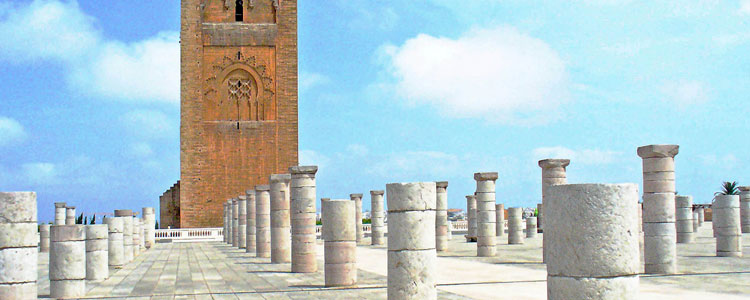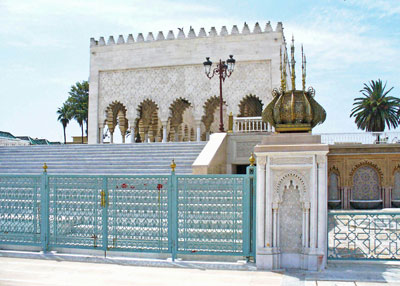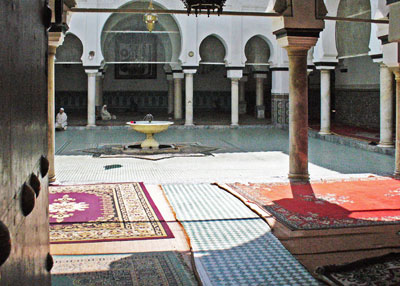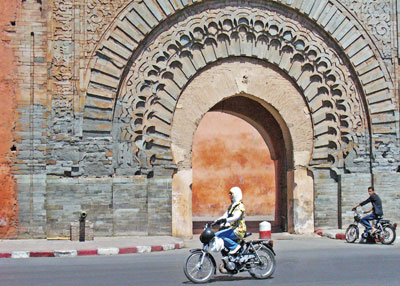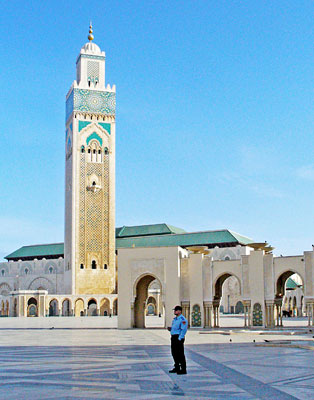Images of Morocco – capturing a sense of place
by David Patten, St. Petersburg, FL
What is a sense of place, and how might I capture it in the photographs I take on a trip? These questions were uppermost in my mind on a trip to Morocco with Insight Vacations, June 3-12, 2010.
Finding a sense of place through my camera lens was more difficult than I imagined. Nevertheless, I think I succeeded in ultimately creating my own very personal visual record of the trip with my small digital camera.
Having documented my trip visually, I am reminded of the sights, sounds and smells of Morocco through my photos.
Fascinating Fès
Morocco is reputed to have one of the world’s finest and most varied cuisines. The most memorable dinner was on our first day in Fès. It was not only the food but the venue that made the time spent at Al Firdaous (10 rue Zenjfour; phone +212 [0] 55 63 43 43) such a magical evening.
The restaurant was located in a historic house dating from the 15th century that once belonged to an aristocratic Moroccan family. The main dining room appeared to have been a courtyard in the home’s center, now roofed over.
Elegant Moroccan tiles and carved stucco decorated the walls; hanging lanterns dimly lit the dining area hung with colorful Moroccan textiles, and live musicians provided unobtrusive background music while we dined.
Fès is the earliest of the Moroccan imperial cities. Historic Fès is a tightly packed city and is best experienced on foot or, where vehicular traffic is allowed, by “petit taxi.” In the medina, only motorcycles and mule-drawn carts are permitted, making for some hazards created by animal droppings and by motorcyclists roaring past only inches away as you seek refuge against the walls of the narrow, winding streets.
The short time our group spent in Fès allowed only a brief glimpse of what this city had to offer. Another factor preventing my experiencing Fès to the fullest is that non-Muslims are forbidden from entering many of the city’s mosques and other religious buildings. Even so, Fès continued to fascinate.
Casablanca
During the tour, stops were made at various carpet, textile, jewelry and apothecary shops. Except for the wide variety of colors and patterns encountered at the carpet and textile shops, I found more inspiration during our trips through the souks of Fès and Casablanca with their small, narrow shops stacked high with merchandise.
Casablanca’s relatively small medina was a joy to explore on my own without the fear of becoming lost in the labyrinthine streets.
A “must see” in Casablanca is the Hassan II Mosque. Standing on a spectacular site bordering the Atlantic Ocean, the mosque is one of the world’s largest religious complexes.
The mosque can contain 25,000 worshipers, and the complex covers an area of nearly 1,000,000 square feet. The massive minaret rises to a height of 689 feet, and two laser beams shine from it in the direction of Mecca.
Built to memorialize King Hassan II (reigning 1961-1999), the huge mosque was opened in 1993. The complex is a skillful piece of Moroccan craftsmanship, with its zellij tilework, carved stucco, travertine, marble and onyx.
Visited on my own, Casablanca’s Cathédrale Sacré-Cœur, or Cathedral of the Sacred Heart, was a strange but fascinating mix of architectural styles. Constructed in installments between 1930 and 1952, the church was designed by the noted French architect Paul Tournon, known especially for his religious buildings constructed in reinforced concrete.
Since the huge, white edifice was open and the admission was free, I entered, finding the nave lined with temporary walls upon which were displayed a large array of contemporary art by a group of Moroccan artists. Above the temporary walls towered stark white columns, a reinforced concrete barrel vault and tall, narrow windows with small openings filled with brightly colored stained glass. The overall impression of the interior was one of restraint — light, airy and majestic.
Meknès
Only two stops were made in Meknès. The first, the Bab Mansour gate, is regarded as one of the finest monumental gateways in Morocco. Located within the walls of the kasbah, the huge gate leads to the Dar el-Kebira quarter and the Place Lalla Aouda.
The gate measures approximately 52 feet in height, while its central, horseshoe arch spans 26 feet. Projecting towers forming loggias frame the central gate.
At the far ends of the gateway are reused ancient Roman columns from the nearby ruins of Volubilis (which was not an included stop on this tour).
Built in the 17th century, the mausoleum of Moulay Ismaïl, our second stop, is somewhat reminiscent of the Saadian tombs of Marrakech. Remodeled in the 18th and 20th centuries, the mausoleum also contains the remains of Moulay Ismaïl’s mother and son as well as those of sultan Moulay Abder Rahman.
The mausoleum is especially notable for its very fine, traditional zellij tile mosaics.
Rabat
The only stop we made in Rabat, Morocco’s capital city, was at the Mausoleum of Mohammed V, regarded as Morocco’s father of independence. Commissioned by his son, King Hassan II, the complex is made up of a mausoleum, a mosque and a museum devoted to the history of the Alaouite dynasty.
The mausoleum of white Carrara marble sits on a platform 11½ feet high. The main entrance to the mausoleum is a monumental staircase flanked by large candelabra with slender candlesticks made of engraved copper.
The cenotaph of the king, composed of a single marble block, rests inside the mausoleum under a 12-sided dome of painted mahogany.
On the exterior, the mausoleum is surrounded by decorative arcades supported by slender marble columns. Although of a recent date, the mausoleum is a masterwork of Moroccan architecture.
Adjacent to the mausoleum stands the Hassan Tower, which has become an emblem of Rabat. Started in 1195 by Yacoub el-Mansour, the huge minaret was never finished. If completed, the minaret would have reached 260 feet in height.
Marrakech
The minaret of the Koutoubia Mosque has become the iconic symbol of Marrakech and is regarded as one of the great works of Muslim architecture. It is the tallest structure in the city and, as such, serves as a point of reference throughout a large portion of the Old City.
Started in 1147 by sultan Abd el-Moumen and completed by his grandson, Yacoub el-Mansour, the minaret is part of one of the largest mosques in the Muslim world. The minaret later served as the model for the Giralda in Sevilla, Spain.
Also of interest is the Palais de la Bahia, a late-19th-century creation of Si Moussa, grand vizier of Sultan Sidi Mohammed ben Abderrahman, and his son, Ba Ahmed, vizier of Moulay Abdelaziz.
Built in two stages, the older section of apartments was built by Si Moussa around a courtyard paved in marble and another open courtyard with plantings and two star-shaped pools.
Throughout the palace are the finest examples of carved plaster, tile and painted decoration. Some of the ceiling decorations were almost beyond belief in their intricate and exquisite detail.
Marrakech’s tombs of the Saadian dynasty are also regarded as some of the finest examples of Muslim architecture in Morocco. In contrast to the architecture of the Almohads, Saadian princes created tombs that were as ostentatious and magnificent as their other buildings.
The tombs date from the late 16th to 18th centuries. Neglected for over two centuries, the tombs were rediscovered in 1917.
More Marrakech
Jacques Majorelle, an expatriate French painter, settled in Marrakech in 1923, building his now-famous villa and gardens. Majorelle’s Moorish-style villa was painted in deep blues, greens and dark reds. Around the villa he designed a lush garden.
The villa and gardens were purchased in 1980 by the famous French couturier Yves Saint Laurent and his partner, Pierre Bergé. They undertook the restoration of the gardens, adding walkways and plantings. The Majorelle Garden now displays varieties of bougainvillea, laurel, geraniums, hibiscus, bamboo and yucca.
The garden also contains 1,800 varieties of cacti and 400 species of palms. Water lilies growing in pools are surrounded by plantings of papyrus.
At one side of the garden stands a single column, a memorial to Saint Laurent, whose ashes were distributed in the garden.
The peaceful serenity of this beautiful garden provided welcome relief after experiencing the frenetic streets of Marrakech and its hectic, touristy square, the Place Jemaa el-Fna.
The Gare de Marrakech, the new railway station, is a remarkable example of a contemporary building. Opened in August 2008, the station replaces the nearby old station, built in 1923 by the French. It is presently the southernmost terminal of the Moroccan railway system, but plans are to extend the railway south to Agadir and Laayone and to upgrade the system to use high-speed trains.
Spectacular scenery
The tour took us via air-conditioned bus through many areas of Morocco’s Middle Atlas region as well as through various villages of the Southern Oasis Route, along the border of the Sahara. The trip from Ouarzazate to Marrakech was especially notable for its spectacular mountain scenery.
The most scenic area on the trip was the Dadès Gorge, located northeast of Ouarzazate.
Flowing through the deep gorge formed by gigantic walls of sheer, reddish rock is the Wadi Dadès, which appeared only as a gentle stream of crystal-clear water but which probably becomes a raging torrent when there are rains upstream. Carrying water from the High Atlas Mountains, this river cuts through the deep canyon and out into the wide Dadès Valley, where oases support areas of fig, almond and walnut trees.
Known as the “Valley of One Thousand Kasbahs,” the Dadès Valley still retains some of its ancient kasbahs, or fortified houses, although many are not well maintained.
Although several so-called cultural connections were scheduled during the trip, meeting and truly interacting with the people of Morocco was not actually feasible unless you were fluent in either French or Arabic. Even so, our visit with an elderly lady whose home had been partially dug into the side of a rocky hill was interesting, as was the process of making Morocco’s sweet mint tea in another small village.
Accommodations
Located in the city of Ouarzazate, notable as the center of Morocco’s movie-making industry, the decor of La Berbère Palace, our hotel there, was enlivened by sculptures that had been used as props in movies made in the area.
At Erfoud, Hotel Belere radiated Moroccan charm. Its central building, housing the lobby, bar and restaurant, was obviously of modern construction but was built very much in the style of the nearby kasbahs.
The one-story buildings housing the guest rooms were also built very much in the style of the local architecture. Although the rooms were Western in style, they still had a distinctly Moroccan decor.
The grounds were of bare earth, but the bungalows were a riot of color created by the climbing flowering vines on the walls. Although located in one of Morocco’s most barren, flat and isolated areas, the hotel was a photographer’s paradise.
Summing up
My 10-day tour, “Best of Morocco,” with Insight Vacations (Anaheim, CA; 888/680-1241) cost $3,385, including a single supplement and air from Tampa, Florida, to Casablanca via JetBlue (to JFK) and Royal Air Maroc.
Did I find a sense of place on my trip to Morocco? Sometimes. Did I discover the soul and spirit of this country of contrasts? Only partially. But the trip, at least, gave me a glimpse into why the country has fascinated so many visitors.

